Cypress Touch Controls
Parent page: Designing with Touch Controls
Facilitating the use of touch sensor technologies in your board designs, Altium NEXUS provides support for creating planar capacitive sensor patterns on your PCB, for use with the range of Cypress® CapSense® and PSoC® controllers.
Supported Sensors
The following self-capacitance sensor types are available for use in your PCB designs:
- Circular Button sensor
- Rectangular Curved Edge Button sensor
- Linear Slider sensor
- Radial Slider sensor
Each channel (electrode) of these sensors has a single, direct connection to the sensor controller. Such sensors are non-directional, in terms of their emitted electric fields. Although they can be used with or without an overlying panel, electrostatic discharge (ESD) implications – for the associated controller device – is a major influence for such a panel being used.
All of these sensors are suited for use with Cypress CapSense and PSoC controllers.
Installing Cypress CapSense Touch Sensor Support
If support has not already been added during initial installation of the software, it can be added from the Configure Platform page, when managing the extensions and updates for your installation (click the  button, at the top-right of the main application window, then choose the Extensions and Updates entry from the associated menu):
button, at the top-right of the main application window, then choose the Extensions and Updates entry from the associated menu):
- From the Installed page of the view, simply click the Configure button at the top-right - to access the Configure Platform page.
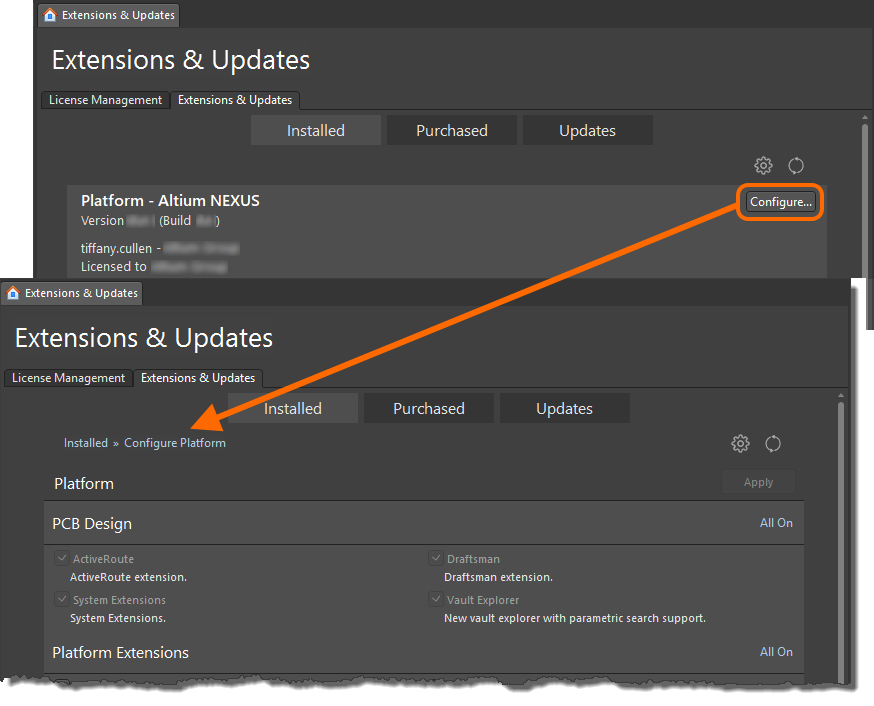 First access the Configure Platform page of the Extensions & Updates view.
First access the Configure Platform page of the Extensions & Updates view.
- Scroll to the bottom of the page and enable the entry for Cypress CapSense, in the Touch Sensor Support region of the page.
 Then enable the Cypress CapSense option, under Touch Sensor Support.
Then enable the Cypress CapSense option, under Touch Sensor Support.
- Click the Apply button, back at the top-right of the page. Altium NEXUS must be restarted for the changes to take effect, so click Yes at the dialog prompt. The required files will be downloaded and installed, and Altium NEXUS restarted. Verify through Windows Explorer that the Cypress CapSense.IntLib is now available - in the \Users\Public\Documents\Altium\AD<VersionNumber>\Library\CapSense folder (for a default installation).
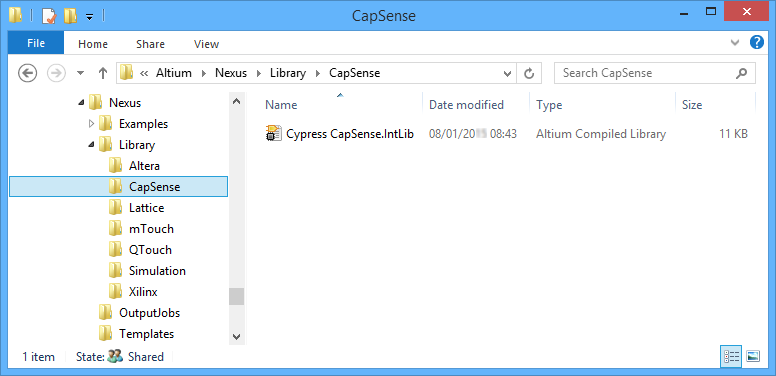 After the installation is updated, the Cypress CapSense integrated library will be available.
After the installation is updated, the Cypress CapSense integrated library will be available.
Sensor Implementation
A touch sensor is implemented in a design by placing and configuring the required sensor type from the dedicated Cypress CapSense integrated library (Cypress CapSense.IntLib).
When configured as required, simply update the target PCB – an ECO is used to effect the required changes, resulting in the creation of the sensor pattern for placement on the PCB. Each sensor component on the PCB isn't a footprint in the normal sense, but rather the actual copper electrode pattern. An overlaying panel would be placed over a sensor when the board is assembled.
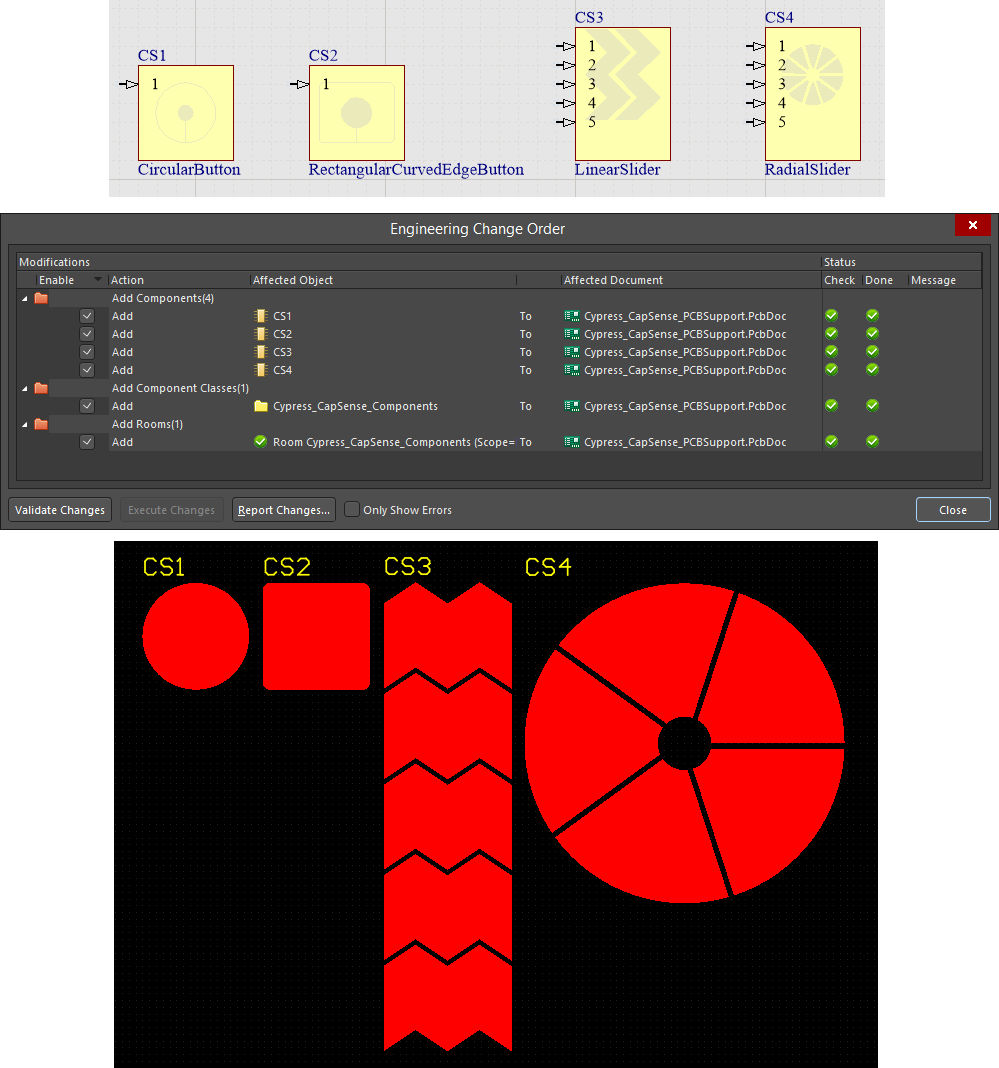 Implementing a touch control is a snap - just place the required sensor type component on the schematic, configure it as applicable to your
Implementing a touch control is a snap - just place the required sensor type component on the schematic, configure it as applicable to your
design needs, then push the changes over to the PCB to obtain the sensor pattern.
The following sections take a closer look at the configurable sensor components available for placement in a design, their configuration options, and the resulting sensor pattern obtained on the PCB side. In each case, the default configurations are presented.
CircularButton
Use the CircularButton component to implement a button sensor. This is a self-capacitance, zero-dimensional sensor, with a single channel for connection directly to a Cypress PSoC controller. The resulting sensor pattern on the PCB is a simple circular-shaped electrode.
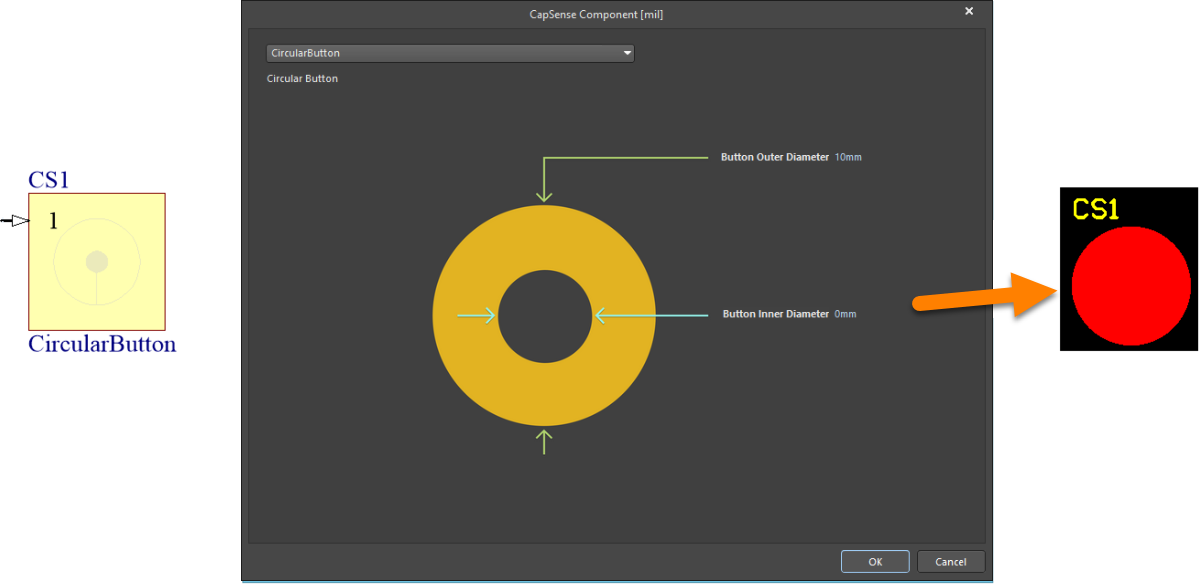 Default configuration and resulting sensor pattern for the CircularButton component
Default configuration and resulting sensor pattern for the CircularButton component
RectangularCurvedEdgeButton
Use the RectangularCurvedEdgeButton component to implement a button sensor. This is a self-capacitance, zero-dimensional sensor, with a single channel for connection directly to a Cypress PSoC controller. The resulting sensor pattern on the PCB is a simple rounded-rectangular-shaped electrode.
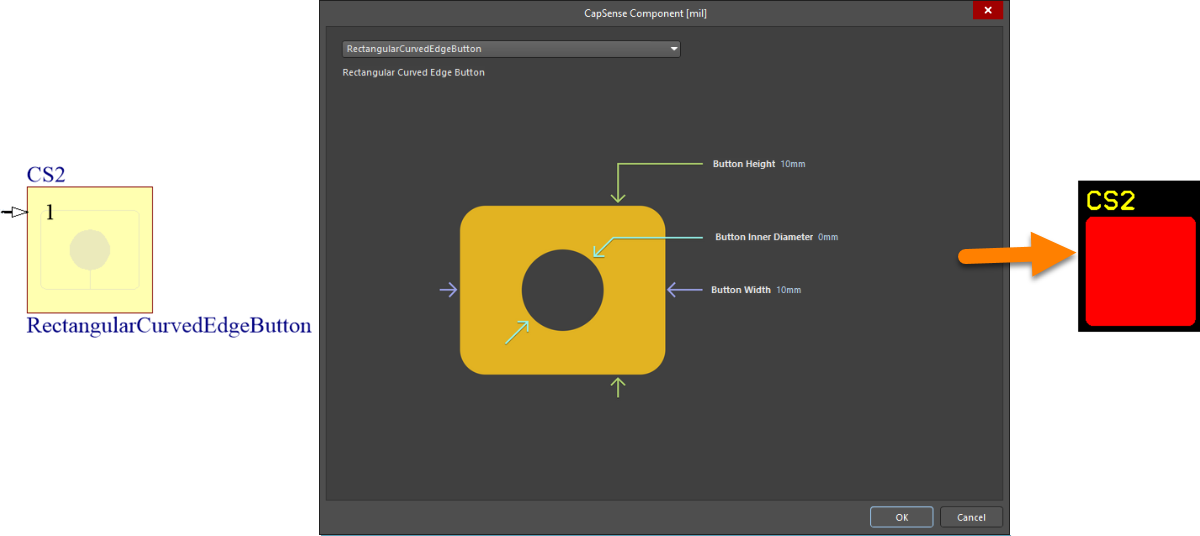 Default configuration and resulting sensor pattern for the RectangularCurvedEdgeButton component
Default configuration and resulting sensor pattern for the RectangularCurvedEdgeButton component
LinearSlider
Use the LinearSlider component to implement an n-segment linear slider sensor. This is a self-capacitance, one-dimensional sensor for connection directly to a Cypress PSoC controller (each segment in the pattern connects to a separate pin of the Controller). The resulting sensor pattern on the PCB is comprised of a 1xn array of double-chevron-shaped electrodes, where n is the number of segments specified. In essence, you are specifying n separate sensors placed physically adjacent to each other. You have global control over the height and width of the constituent sensors. You can also control the gap between neighboring sensors.
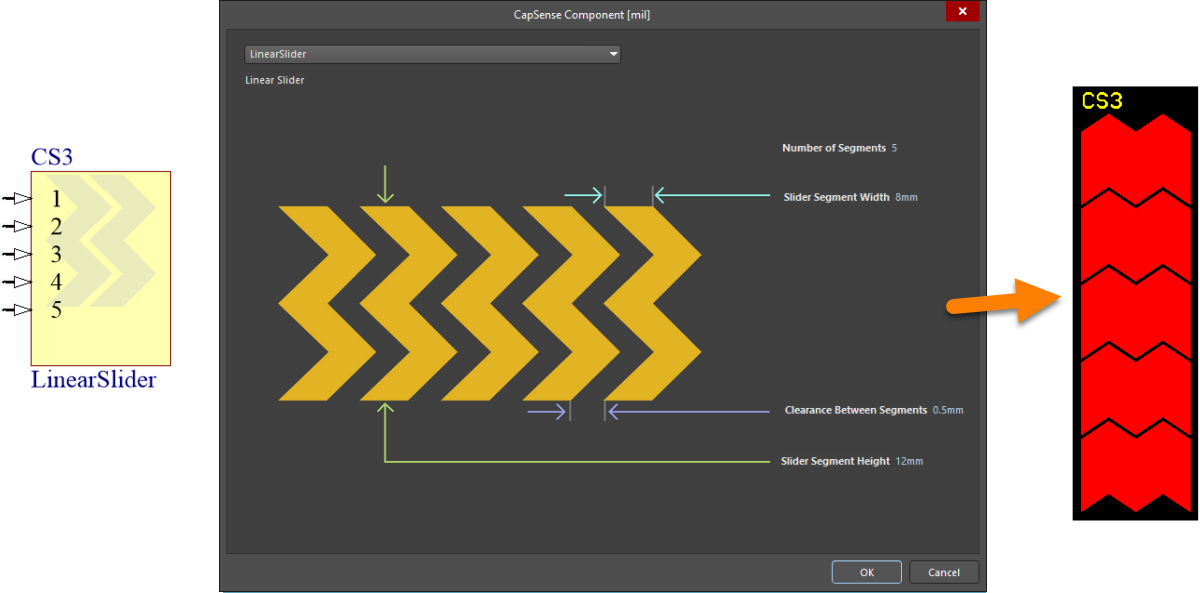 Default configuration and resulting sensor pattern for the LinearSlider component
Default configuration and resulting sensor pattern for the LinearSlider component
RadialSlider
Use the RadialSlider component to implement an n-segment radial slider sensor. This is a self-capacitance, one-dimensional sensor for connection directly to a Cypress PSoC controller (each segment in the pattern connects to a separate pin of the Controller). The resulting sensor pattern on the PCB is comprised of n wedge-shaped electrodes, where n is the number of segments specified. In essence, you are specifying n separate sensors placed physically adjacent to each other in radial fashion. You have global control over the inner and outer diameter of the slider, and the clearance between neighboring segments.
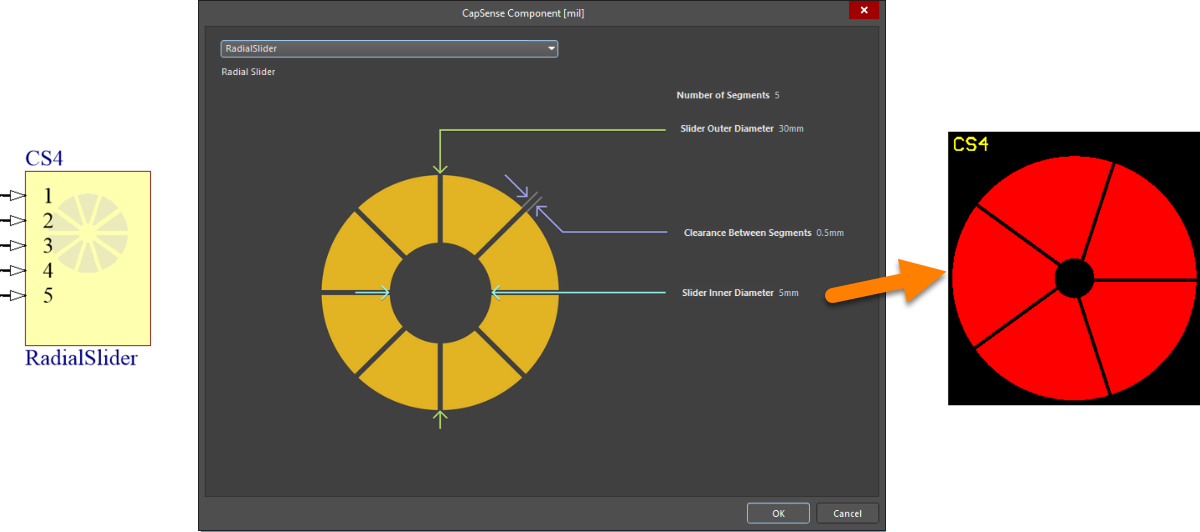 Default configuration and resulting sensor pattern for the RadialSlider component
Default configuration and resulting sensor pattern for the RadialSlider component
Cypress Sensor Controllers
Cypress's CapSense Controllers – to which the corresponding electrodes from the sensor patterns connect – are based on the Programmable System-on-Chip (PSoC®) platform. CapSense Controller categories include:
- CapSense®
- CapSense® Plus
- CapSense® Express
- The families of PSoC® Controllers - PSoC® 1, PSoc® 3, PSoC® 4, and PSoC® 5LP (which replaced the PSoC® 5 family).
These controllers can be found on the Cypress CapSense Controllers, and relevant PSoC pages (PSoC 1, PSoC 3, PSoC 4, PSoC 5, PSoC 5LP) within the Unified Components section of the Design Content area of the Altium Website.
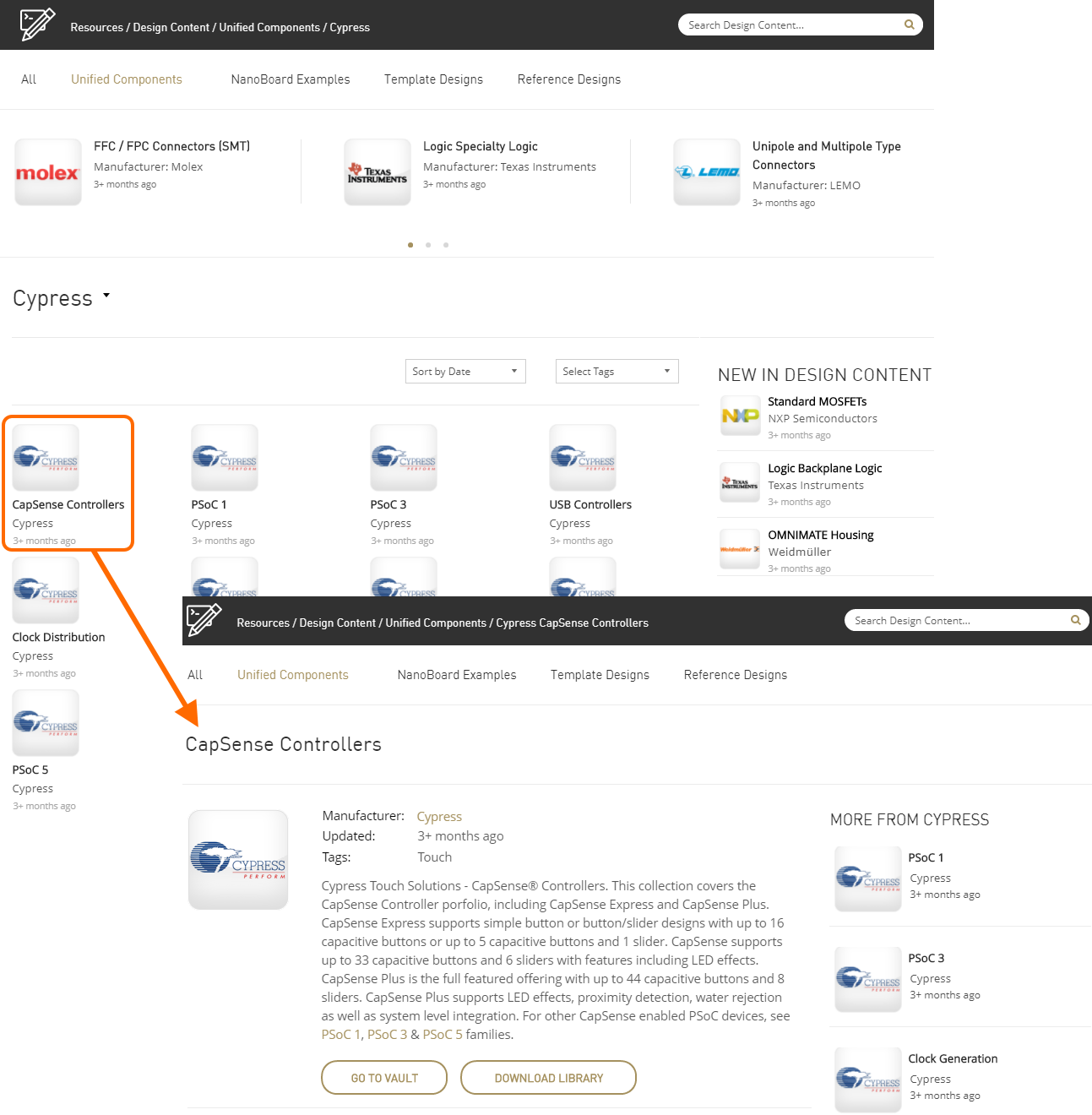 Browse CapSense Controller components on the Altium Website.
Browse CapSense Controller components on the Altium Website.
Components can be browsed directly on these pages. In addition, each page offers the following two options:
- Go To Vault - click this button to browse the components through the browser-based interface to the Altium Content Vault in which the components reside.
- Download Library - click this button to download the components in a zipped integrated library file.
Alternatively, connect to the Altium Content Vault through Altium NEXUS and place components directly into your designs.
The CapSense Controllers can be found in the following vault folders:
- Unified Components\Components\Cypress\Touch Sensing\Capsense Controllers
- Unified Components\Components\Cypress\Programmable System-on-Chip\PSoC 1
- Unified Components\Components\Cypress\Programmable System-on-Chip\PSoC 3
- Unified Components\Components\Cypress\Programmable System-on-Chip\PSoC 4
- Unified Components\Components\Cypress\Programmable System-on-Chip\PSoC 5
- Unified Components\Components\Cypress\Programmable System-on-Chip\PSoC 5LP
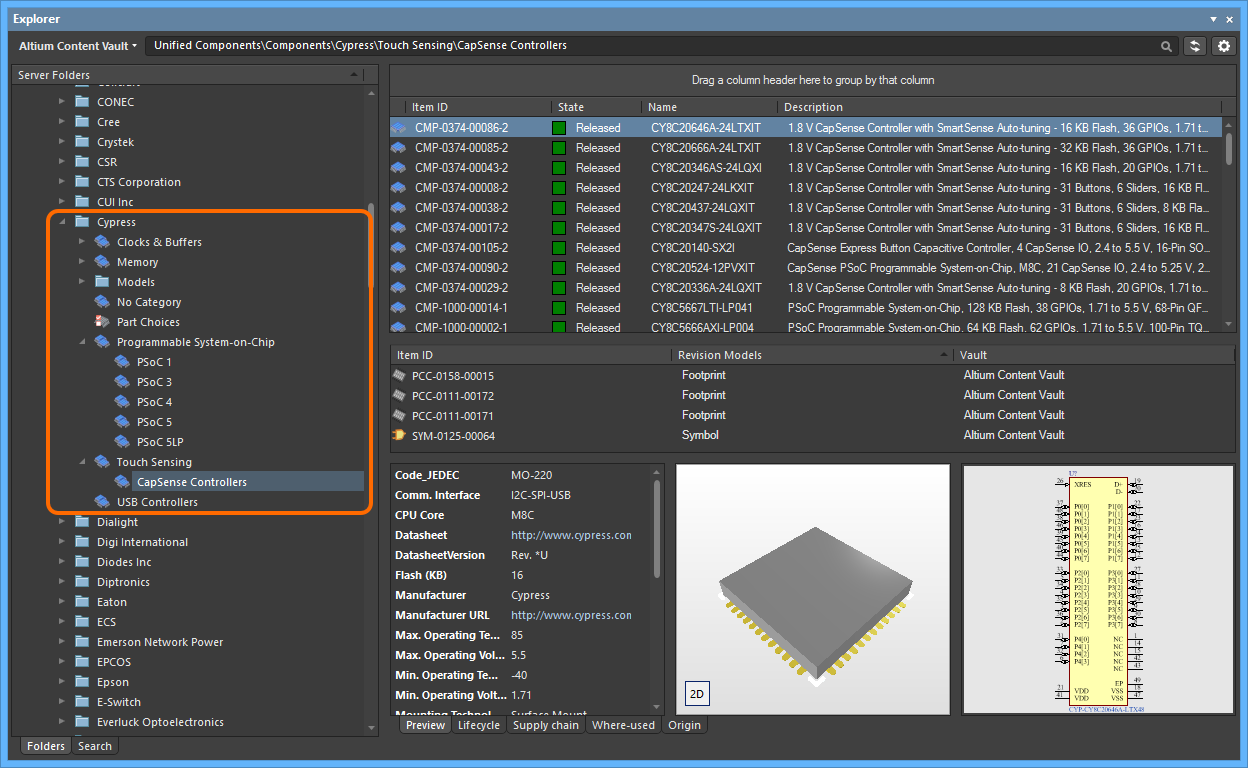 Access the range of CapSense Controllers in the Altium Content Vault, available for placement in your designs through the Explorer panel.
Access the range of CapSense Controllers in the Altium Content Vault, available for placement in your designs through the Explorer panel.
Further Information
For detailed information regarding Cypress's capacitive touch sensor design, see www.cypress.com/products/capsense-controllers.
